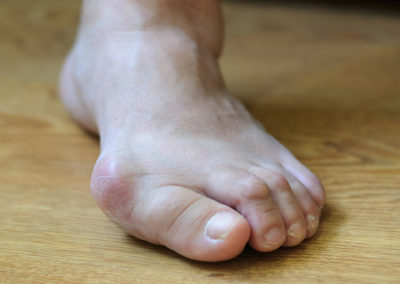Toe Deformities
What are Toe Deformities?
Hammer toes, clawed toes and mallet toes are some of the most common toe deformities and all can be embarrassing and painful conditions. They occur when the toe has buckled and there are several effective procedures to reset the joint or fuse it into the corrected position.
What are the Treatment Options for Toe Deformities?
Thankfully there are several effective procedures to reset the joint or fuse it into the corrected position.
Non-Surgical Treatment
Whilst conservative treatment options, such as splits, orthotics and custom footwear can provide some comfort they are unlikely to straighten the affected toe. When non-surgical treatments do not adequately help, surgery to correct the hammer, mallet or claw toe deformity will usually permanently cure the condition.
Surgical Treatment
There are two types of surgery recommended at Kann Foot Surgery:
- Digital Excision Arthroplasty (Hammer Toes)
- Digital Fusion (Hammer or Mallet Toes)
Digital Excision Arthroplasty
This operation is performed because your toe has buckled leading to a hammer, mallet or claw toe deformity. The deformity could be at either of the two joints in your toe. Often pressure from the shoe makes the joint sore and in extreme cases, the skin could ulcerate. This procedure is designed to straighten the toe via removal of the joint. This should leave the toe flexible and straight.
Digital Fusion
This operation is also performed because your toe has buckled leading to a hammer, mallet or claw toe deformity. Surgery is aimed at straightening the toe by removing part of the joints and fusing the bones together. This will allow the toe to flatten and thereby remove pressure from the shoe. The bones are held together either by a temporary wire or an internal ‘intra-medullary’ implant.
Are There Risks or Side-Effects Following Surgery to Fix Toe Deformities?
As with any medical procedure, there are risks which Mr. Kannegieter will always thoroughly explain to you prior to your treatment, so you can be informed every step of the way.
The main risks following surgery are:
• Pain
• Swelling
• Infection
• Deep vein thrombosis
• Complex regional pain syndrome
• Scarring
Specific complications of arthroplasty
- The toe may not grip the ground as well as it used to.
- In some cases, the joint of the toe may become thicker.
- The deformity can recur; some of the bone can re-grow.
- Sometimes, the toe may remain slightly floppy.
Specific complications of digital fusion
- The toe may not grip the ground as well as it used to. This is rarely a problem.
- In some cases, the joint of the toe may become thicker with time and the other joint in the toe might buckle.
- The toe may be swollen after the operation; rarely, this can persist.
- Sometimes, the scar line is sore. This will normally ease with time.
- Delayed or nonhealing for the fusion.
- In extremely rare cases there is the risk of loss of the toe.
What Happens After Surgery?
Both operations usually take between 20 – 30 minutes. You will have a bulky dressing on your foot and you will be given a post-operative shoe to wear.
After the operation you will return to the ward, and when advised by the nurses, you can eat and start taking your painkillers. Your surgeon will then visit you to answer any questions and discharge you from hospital.
You should not drive after foot surgery and should be accompanied home by a responsible adult.
You will be advised of your follow up appointment date, either on the day or by letter in the post.

Resources
Mr. Kannegieter has put together the following useful PDFs explaining what to expect from surgery to correct toe deformities.
